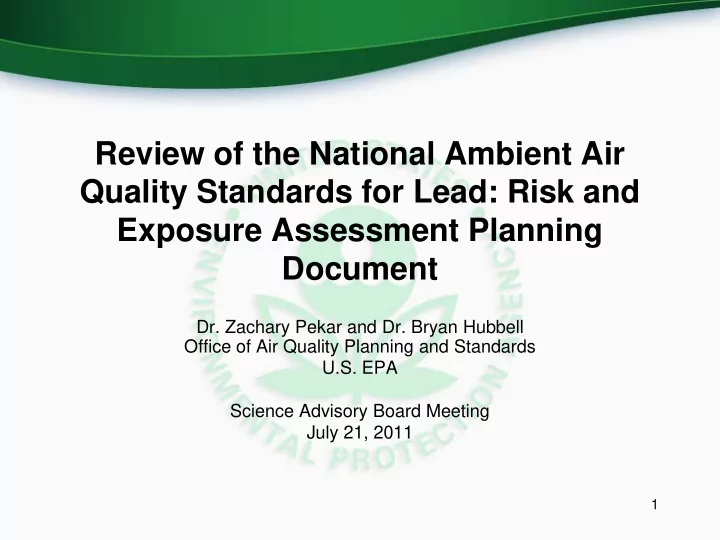

Review of the National Ambient Air Quality Standards for Lead: Risk and Exposure Assessment Planning Document Dr. Zachary Pekar and Dr. Bryan Hubbell Office of Air Quality Planning and Standards U.S. EPA Science Advisory Board Meeting July 21, 2011 1
Purpose of the Planning Document • Assess the extent to which the evidence newly available in this review warrants new quantitative human health and ecological risk assessments, considering: – Key uncertainties and limitations impacting risk estimates developed in risk assessment completed for last review – Degree to which newly available evidence allows us to substantively address key uncertainties and limitations • Potential to provide notable different exposure/risk estimates, with lower associated uncertainty • Document organization: – Human health risk assessment – Welfare/ecological risk assessment 2
Overview of Human Health Risk Assessment (from previous review) • Assess IQ loss in children up to 7yrs of age • Case study based analysis – More highly air-pathway exposed young children • General urban study area • Primary Pb smelter study area – Children experiencing a broader range of air exposures - location- specific urban study areas (Chicago, Cleveland, Los Angeles) • Multipathway analysis – Air-related pathways: inhalation, ingestion of Pb in indoor dust and outdoor soil Pb • Indoor dust critical pathway: hybrid empirical/mechanistic residential dust model • Distinguished recent and past air-related exposure – Other pathways: paint (nonair), diet and drinking water (qualitatively recognized as air-related) 3
Overview of Human Health Risk Assessment (from previous review) - continued • Ambient air Pb characterized using monitors and dispersion modeling • Blood Pb exposure metric – IEUBK model – Interindividual variability in blood Pb characterized using statistical measure of PbB variation in US residential population • IQ loss based on Lanphear (2005) pooled analysis – 4 CR functions – log-linear and dual linear models 4
Key Ares of Uncertainty and Limitations in the Human Health Risk Assessment (from previous review) • Temporal aspects : media concentrations remain fixed over 7yr simulation period. • General urban study area: extrapolation to larger urban population is difficult. • Location-specific urban study areas: representation of spatial gradient in ambient air levels. • Air quality simulation: estimation of air concentrations associated with different standard levels (rollback). • Outdoor soil/dust Pb concentrations: lacking data/methods for simulating impact of change in Pb standard on soil levels. 5
Key Ares of Uncertainty and Limitations in the Human Health Risk Assessment (from previous review) - continued • Indoor dust Pb concentrations: modeling indoor dust Pb and impact of changes in ambient air Pb levels. • Inter-individual variability in PbB levels: predicting high-end PbB and related IQ loss. • Pathway apportionment of risk at higher percentiles: apportioning exposure and risk between air and non-air related pathways for highly exposed children. • IQ loss CR functions: characterizing slope at lower exposure levels. 6
Overview of Key Observations Presented in the Planning Document (for human health risk) • Newly available information released since the last review may be useful in further interpreting risk estimates generated for the previous review, thereby enhancing their utility in informing the current review. • However, we do not believe that the information newly available in this review provides the means by which to develop an updated or enhanced risk model that would substantially improve the utility of risk estimates in informing the current Pb NAAQS review. – It is unlikely that any of the primary sources of uncertainty identified to have the greatest impact on risk estimates would be substantially reduced by using this new information to update the risk model, including inputs to that model. 7
Ecological Risk Assessment • Overview of the Last Review • Critical Loads as a Concept for Risk Assessment • Summary of the Current Review 8
Overview of the Last Review • Screening Level Assessment – Three Case Study Areas • Primary Smelter, Secondary Smelter, Near-Roadway Non-urban • A fourth, ecologically sensitive area was assessed, but not part of the quantitative assessment – National-scale screening assessment 9
Screening Level Assessments • Based on Hazard Quotients (HQ), using Ecological Soil Screening levels (Eco-SSLs) and Ambient Water Quality Criteria (AWQCs) • HQ was calculated as: HQ = estimated concentration/Eco-SSL • The assessments found a number of areas with HQ > 1, indicating those areas were potentially at risk. • Data were not sufficient to assess the portion of risk attributable to ambient air concentrations. 10
Critical Load Models • Since the last review the Agency’s understanding of how the Critical Load (CL) concept can be applied in a risk assessment has improved. • The NOx/SOx secondary standard developed a methodology for applying CL’s that has been reviewed by CASAC. • The HQ concept used in the previous review of Pb includes two components of a CL approach, Current Conditions and the Critical Limit. 11
Primary Limitations to CL Models during the Last Review • Existing studies did not incorporate speciation or bioavailability into CL models. • There was an overall lack of data regarding fluxes of Pb within systems that was used in the CL models. • No studies using CL models had been completed in the United States, which was an indication of the lacking of data. 12
New Information in the Review • The new information reviewed in the draft ISA supports and expands previous findings regarding bioavailability, speciation and ecological effects. • One new study did include fluxes in their CL Model. • Data are still lacking to apply a CL model approach over a large enough scale or even for a pilot study of several smaller areas. 13
Summary • The currently available data would not allow for a CL based risk assessment that would substantially change or improve on the HQ approach used in the last review. • The agency does feel that the CL concept is the appropriate tool for assessing ecological risks from Pb moving forward. 14
Recommend
More recommend